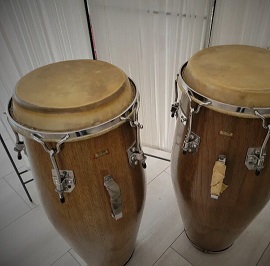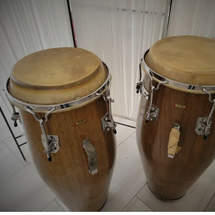Posted by Steve Head on 3rd Apr 2023
A Detailed Guide On How To Tune A Conga Drum
The conga is a percussion instrument that originates from Cuba and is widely used in Latin American music. It is made up of a wooden drum with a narrow, tapered body and a drumhead made of animal skin or synthetic material. Tuning a conga can be a tricky process, but with some patience and attention to detail, you can achieve the desired sound.

Before tuning your conga, it's important to ensure that the drumhead is in good condition. If it's worn out or damaged, you'll need to replace it before you can tune the drum properly. If you're using a synthetic drumhead, it should be stretched tightly over the drum to create a high-pitched sound. If you're using an animal skin drumhead, it needs to be soaked in water for at least 30 minutes before you begin tuning.
To tune your conga, start by loosening the tension rods on the drumhead using a drum key. Turn the key counterclockwise to loosen the rods, being careful not to damage the threads. Loosen each rod a little bit at a time to ensure that the tension is released evenly across the drumhead.
Once the tension rods are loosened, place the conga on a flat surface and tap the drumhead gently with your fingers. Listen carefully to the sound that it produces – it should be a low, dull thud. If the sound is too high-pitched, the drumhead is too tight and needs to be loosened further. If the sound is too low or the drumhead feels slack to the touch, the drumhead needs to be tightened.
To tighten the drumhead, start by tightening the tension rods opposite each other, rather than in a circular pattern. This ensures that the tension is distributed evenly across the drumhead. Use a drum key to turn each rod clockwise, tightening it gradually until the drumhead feels firm to the touch.
Once you've tightened the tension rods, tap the drumhead gently with your fingers again to check the sound. It should be a higher-pitched tone than before, but not too high. If the sound is too high, the drumhead is too tight and needs to be loosened slightly. If the sound is too low, the drumhead needs to be tightened further.
Continue tuning the drumhead in this way, making small adjustments to the tension rods until you achieve the desired sound. It's important to take your time and not rush the process, as over-tightening or under-tightening the drumhead can cause damage to the drum or affect the sound quality.
Once you're happy with the tuning of your conga, it's a good idea to mark the positions of the tension rods on the drumhead using a permanent marker. This will make it easier to tune the drum in the future, as you can use the marks as a guide to ensure that the tension is evenly distributed.
In conclusion, tuning a conga is a process that requires patience, attention to detail, and a good ear. By following the steps outlined above, you can achieve a well-tuned conga drum that produces the desired sound. Remember to take your time, make small adjustments, and mark the positions of the tension rods to make tuning easier in the future. With practice, you'll be able to tune your conga quickly and easily, allowing you to focus on playing and enjoying the music.
As an Amazon Associate, I earn from qualifying purchases. This means that if you click on the link and make a purchase, I may receive a small commission at no extra cost to you. This helps support my work in providing quality content. Thank you for your support!
Check out my blog post:


